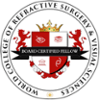Quality of Vision Measurement
What is it?
Our vision can be separated into two elements: vision quantity and vision quality.
Vision quantity – or visual acuity – is measured based on the letters we can read on a standard letter chart. For example, 20/20 vision (meaning you can see at 20 feet what a normal-sighted person can see at 20 feet) is a measurement of visual acuity. This is typically regarded as the desirable level of visual acuity.
However, it is possible to have 20/20 vision – or even better – and still have poor vision quality. This is because vision quality can be affected by visual disturbances such as glare, halos, starbursts, double imaging, and reduced contrast sensitivity.
How Does it Work?
Various devices may be used to measure your quality of vision, including the HD Analyser and the C-quant.
The HD Analyser works by evaluating how light is scattered by the eye – known as the “objective scatter index”. This provides a picture of what a light source looks like to the patient. For example, while the picture would look like a small circle in a normal eye, the picture can become larger and distorted in an eye with a cataract.
The C-Quant also evaluates light scatter – known as “straylight” – by evaluating feedback from the patient when they are exposed to different image patterns. The light distortion analysis system measures the size and shape of halos and starbursts in a patient’s vision, based on their feedback when looking at a light source.
These devices are currently only available at a few refractive surgery clinics in the UK, yet they are considered an integral resource when managing patients who are not satisfied with their quality of vision.
What are the Benefits?
Carrying out an assessment of vision quality, in addition to visual acuity, gives your surgeon a clear indication of what you actually see. This information, in combination with other data collected through various scans and tests, makes it easier to make an informed and accurate diagnosis.
Consequently, your surgeon will be more able to make an appropriate treatment recommendation. For example, quality of vision measurements can be used to detect the visual significance of early cataract formation.
It is uncommon for Laser Eye Surgery to significantly reduce quality of vision. Furthermore, any changes are usually manageable with further treatment in the majority of cases.
What will I feel?
Taking Quality of Vision measurements does not require an instrument to make direct contact with your eye. Therefore, you won’t feel anything during this step of the screening/aftercare process.


